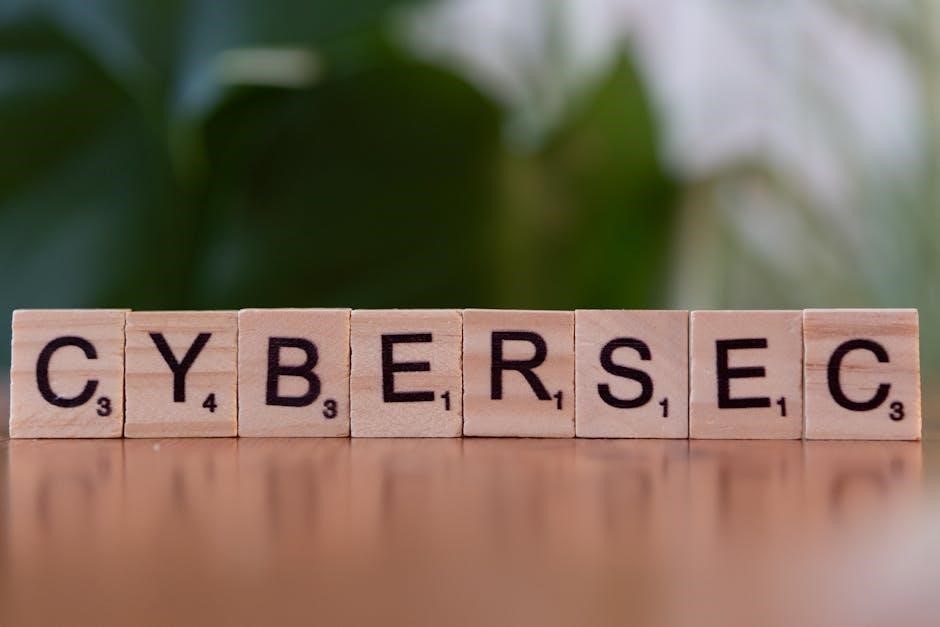Cybersecurity involves protecting electronic data from unauthorized access and malicious activities. It encompasses people, processes, and technologies designed to safeguard sensitive information and ensure system integrity.
1.1 Key Concepts in Cybersecurity
Cybersecurity revolves around core concepts like confidentiality, integrity, and availability (CIA triad). These principles ensure data remains private, unaltered, and accessible. Authentication methods, such as passwords or biometrics, verify user identity. Vulnerabilities refer to system weaknesses exploited by attackers, while threats include malware, phishing, and ransomware. Security tools like firewalls, antivirus software, and encryption protect against these threats. Risk management involves identifying and mitigating potential attacks. Understanding these concepts is essential for building a secure digital environment and safeguarding sensitive information from cyber threats.
1.2 Importance of Cybersecurity in the Digital Age

In the digital age, cybersecurity is crucial for protecting sensitive data, systems, and infrastructure from unauthorized access and malicious activities. As technology advances, cyber threats have become more sophisticated, targeting individuals, businesses, and governments. Cybersecurity ensures the confidentiality, integrity, and availability of digital information, which is vital for maintaining trust and security in online transactions. It also safeguards personal privacy, prevents financial losses, and protects critical infrastructure from cyberattacks. With the increasing reliance on digital technologies, the importance of cybersecurity continues to grow, making it a cornerstone of modern digital life and global economic stability.
1.3 Evolution of Cybersecurity Threats
Cybersecurity threats have evolved significantly over the years, from basic viruses to sophisticated attacks. Initially, threats were limited to malware and viruses targeting individual systems. However, with advancements in technology, cybercriminals developed more complex methods, such as ransomware, phishing, and advanced persistent threats (APTs). Modern threats often exploit vulnerabilities in software, human behavior, and network configurations. The rise of AI and machine learning has further enabled attackers to create highly tailored and stealthy attacks. Today, state-sponsored actors and organized cybercriminal groups pose significant risks to individuals, businesses, and critical infrastructure. This evolution underscores the need for adaptive and robust cybersecurity strategies to stay ahead of emerging threats.

Common Cybersecurity Threats and Attacks
Cybersecurity threats include malware, phishing, ransomware, and advanced persistent threats (APTs), targeting data, systems, and users to compromise integrity, confidentiality, or availability.
2.1 Types of Cyber Threats (Malware, Phishing, Ransomware)

Cyber threats include malware, phishing, and ransomware. Malware, short for malicious software, damages or disrupts systems, stealing data or hijacking devices. Phishing tricks users into revealing sensitive information through deceptive emails or fake websites. Ransomware encrypts data, demanding payment for its release. These threats exploit vulnerabilities, targeting individuals and organizations to cause financial loss or data breaches. Understanding these threats is crucial for implementing effective security measures to protect digital assets and maintain privacy. Regular updates, strong passwords, and awareness are key defenses against such attacks.
2.2 Real-World Examples of Cyber Attacks
Notable cyber attacks include the SolarWinds breach, which compromised U.S. government and corporate data in 2021, and the Colonial Pipeline ransomware attack in 2021, disrupting fuel supplies. The 2017 Equifax breach exposed sensitive data of millions, while the WannaCry ransomware attack in 2017 affected healthcare systems globally. These incidents highlight vulnerabilities in supply chains, critical infrastructure, and personal data security. They underscore the importance of robust cybersecurity measures to prevent and mitigate such attacks, protecting sensitive information and maintaining public trust in digital systems.

Cybersecurity Best Practices
Adopt strong passwords, regularly update software, use encryption, and secure personal information online to safeguard against cyber threats effectively and maintain digital security.
3.1 Password Protection and Management
Password protection is critical to cybersecurity. Use strong, unique passwords for each account, avoiding common words or personal information. Regularly update passwords and enable multi-factor authentication for added security. Avoid reusing passwords across multiple accounts to prevent widespread compromise in case of a breach. Consider using a password manager to securely store and generate complex passwords. Ensure passwords are at least long, combining letters, numbers, and special characters. Never share passwords or write them down in insecure locations. Implement password policies in organizations to enforce these practices and conduct regular audits to maintain security hygiene.
3.2 Securing Personal Information Online
Securing personal information online is essential to prevent identity theft and unauthorized access. Always be cautious when sharing sensitive data, such as addresses or financial details, on websites or social media. Enable privacy settings on platforms to limit who can view your information. Avoid using public Wi-Fi for transactions involving sensitive data, as it may be unsecured. Use encryption for emails or messages containing personal information. Regularly monitor your accounts for suspicious activity and report any discrepancies immediately. Educate yourself about phishing attempts and never click on suspicious links or download attachments from unknown sources. Protecting your personal information online requires constant vigilance and proactive measures to stay safe in the digital world.
Cybersecurity Career Opportunities
Cybersecurity offers diverse career opportunities in roles like Ethical Hacker, Security Analyst, and more. High demand exists for skilled professionals to protect digital assets and systems effectively.
4.1 Roles in Cybersecurity (Ethical Hacker, Security Analyst)
In cybersecurity, roles like Ethical Hackers and Security Analysts play crucial roles in safeguarding digital assets. Ethical Hackers, also known as White Hat Hackers, simulate cyberattacks to identify system vulnerabilities, ensuring organizations can fix weaknesses before malicious actors exploit them. Security Analysts monitor networks, implement security measures, and respond to incidents to protect sensitive data. These professionals are essential in maintaining organizational security and trust. Their expertise ensures systems remain resilient against evolving threats, making them indispensable in today’s digital landscape.
4.2 Skills Required for a Career in Cybersecurity
A career in cybersecurity demands a combination of technical and soft skills. Proficiency in networking fundamentals, encryption, and firewalls is essential. Knowledge of programming languages like Python and C++ is also critical for developing secure systems and analyzing threats. Additionally, understanding incident response and ethical hacking practices is vital. Problem-solving skills and attention to detail are equally important to identify vulnerabilities and mitigate risks. Communication skills are necessary to explain complex security concepts to non-technical stakeholders. Staying updated with evolving technologies and threats is crucial, as the field is constantly changing. These skills enable professionals to protect sensitive data and maintain organizational security effectively.
Educational Resources for Learning Cybersecurity
Explore recommended courses, certifications, and study materials to gain foundational knowledge and practical skills in cybersecurity, essential for building a strong understanding of the field.
5.1 Recommended Courses and Certifications
course, covering trends and career opportunities. Additionally, the Global Information Security Fundamentals (GISF) certification prepares learners for entry-level roles. These resources provide practical skills and theoretical understanding, essential for building a career in cybersecurity. They also cover topics like risk management, ethical hacking, and security best practices, ensuring a comprehensive learning experience.
5.2 Useful Study Materials and Tools
by ITU provide foundational knowledge. Online platforms such as Quizlet offer flashcards for key terms like cybercrime and security tools. Practical tools like Wireshark for network analysis and Metasploit for penetration testing are essential for hands-on experience. These resources help learners understand concepts such as firewalls, encryption, and threat detection. They also provide insights into real-world applications, making them invaluable for both beginners and professionals aiming to deepen their cybersecurity expertise.